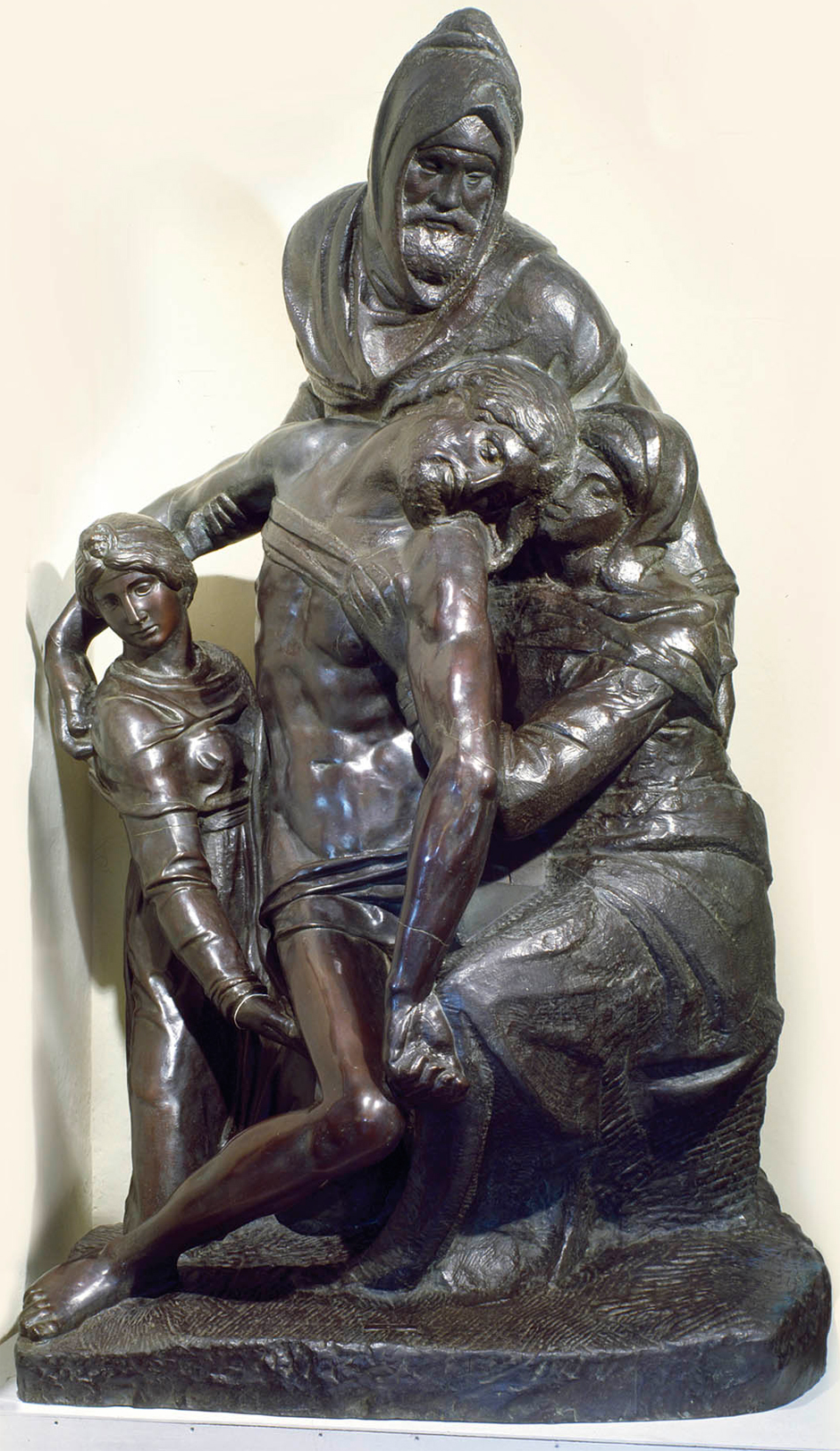The Florentine Pietá, also known as “The Deposition” (1547–1553; height: 93 inches) Museo dell’Opera del Duomo.
Michelangelo is estimated to have been 73 years old when he began work on this Pieta, which was destined to be placed in Santa Maria del Fiore, the cathedral in Florence. He worked on it intermittently for about ten years while he carried out other projects which had been thrust upon him. This Pietá was not a commissioned work, and was believed to have been intended for his own tomb. Mary, Mary Magdalene, and Nicodemus (properly, Joseph of Arimathea) support the crumpled figure of Christ. The statue was left unfinished after the leg of the Christ figure had been broken. A pupil and young friend, Tiberio Calcagni, attempted to complete the statue but died before he had done damage to the masterpiece. In the said that in the tender face of Joseph one recognizes the features of Michelangelo himself.
Provenance of The Florentine Pieta by Michelangelo
Michelangelo di Lodovico Buonarotti Simoni
(Florence 1475 – 1564 Rome)
The Florentine Pieta
Selected Reference Literature:
Condivi, Vita di Michelangelo Buonarroti…1553; Giorgio Vasari, Lives of the Most Eminent Painters, Sculptors, and Architects, 1550; Charles de Tolnay, Michelangelo: Sculptor, Painter, Architect, 1975; Robert Coughlan, The World of Michelangelo 1475-1564, 1972; Nathaniel Harris, The Art of Michelangelo, 1983; Goldscheider, Ludwig, Michelangelo: Paintings, Sculptures, and Architecture, 1975; Georgia Illetschko, I Michelangelo, 2004; Clements, Robert J. Michelangelo: A Self Portrait, 1968.
The Deposition, often referred to as the Florentine Pieta, was a sculpture in which Michelangelo intended for his own tomb but his wishes were not carried out. From the late 1540’s Michelangelo was working on the deposition for his own tomb, but either became dissatisfy with it or discovered a flaw in the marble. He smashed the sculpture in anger but later an assistant was allowed to patch it up.
The composition is a development of the Pieta drawn for Vittoria Colonna and also inspired by certain Quattrocento Pietas. The dead body is supported in a vertical position in Michelangelo’s statue: The Virgin and Mary Magdalene to the right and left, and in the center behind Christ is Nicodemus. Michelangelo gave the cowled face of Nicodemus features reminiscent of his own, relaxed with compassion for the dead Christ. The self-portrait seems to be Michelangelo’s attempt at “an old man’s intense yearning for oneness with God.”
For this work Michelangelo tried in his later years to:
“Return to the elemental harmony and intimacy of his first pieta.”
His work in the last years was an attempt to become one with God and to secure his place in heaven.
“The sheer physicality of this sculpture defies the transcendence of a non-symbolic art geared towards the subjective experience of the Christian mystery.”
Giorgio Vasari writes about Michelangelo’s Pieta that:
“At this time Michelangelo worked on the Pieta almost everyday as a pastime. At last he broke the stone, probably because it contained veins of emery and was so hard the chisel struck sparks from it; perhaps also because his criticism of his own work was so severe that nothing he did satisfied him. For this reason, to tell the truth, there are few finished works by him in his later period, when he had reached the highest maturity of his artistic power of creation. His finished sculptures all date from his early period.”
In a poem written by Michelangelo, he writes during this time:
“In such slavery, and with so much boredom, and with false conceptions and great peril to my soul, to be here sculpting divine things.”
In a quote by French Traveler Blaise de Vigenere, it is easy to see the virility of Michelangelo even in his old age. He writes:
“I saw Michelangelo at work. He had passes his sixtieth year and although he was not very strong, yet in a quarter of an hour he caused more splinters to fall from a very hard block of marble than three young masons in three or four times as long…And he attacked the work with such energy and fire that I thought it would fly into pieces. With one blow he brought down fragments three or four fingers in breadth, and so exactly at the point marked, that if only a little more marble had fallen, he would have risked spoiling the whole work.”
Vasari goes on to say that Michelangelo gave the broken Pieta to Francesco Bandini to be finished by the artist Tiberio Calcagni, but Tiberio died shortly after he made some slight changes to the sculpture. It is said by Vasari that:
“When one sees what [Tiberio] did, one can see that his death was a good thing for the Pieta. Tiberio was responsible for the highly polished and minutely chiseled Magdalene, which must have been very beautiful before; he was also responsible for polishing the trunk of the Christ and the sharp folds of the shroud.”
In his own word Michelangelo writes in a letter to Giorgio Vasari:
“I have reached the twenty-fourth hour of my day, and…no project arises in my brain which has hath not the figure of death graven upon it.”
In one of Michelangelo’s final poems, he confronts death and in some ways accepts and welcomes it.
“Of death I am sure, but not of the time;
Life is short and little remains before me;
My senses are deleted, however I am bound for
Heaven, and she prays that I go.”
Vasari had proposed that this sculpture be placed on Michelangelo’s tomb, as Michelangelo had intended but these wishes were not carried out. Initially, the sculpture was left in the open air in a Vineyard on Monte Cavallo, and in 1664 it was transferred to Florence. It was first placed in San Lorenzo and in 1772 it was placed behind the high altar of the cathedral, and in 1993 it was placed in the chapel of the north choir.

